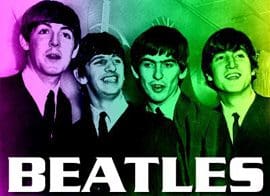Helping Children’s Behaviour and Wellbeing by using British Sign Language: With Help from The Beatles!

I was leading a story session in a nursery once, and we were having a few problems getting the children to settle down. Even though I had loads of resources and was going to make the story as exciting and interactive as possible, a few children were messing about. (There’s no other way to describe it: they were having fun being silly.)
My colleague said to the children, “Oh dear, you are making Michael very sad, because you are keeping all of us waiting to hear his story. At the time, I thought, “Actually I’m not sad about this: I’m getting quite frustrated. If I am not careful, I will show the children that I am getting annoyed and cross. I might even get angry, or lose my temper, or even fly into a storming rage. Don’t worry; I didn’t do any of those things. However I did tell the children that I was starting to feel bored with waiting.
Apparently using the word bored was a very bad choice of word on my part, as several staff became very annoyed with me, because the word caught on like wildfire among the children, and they started to use it a lot once I had gone: ‘This is boring/I’m bored’ etc. In another setting, I was reading a story about a monkey who was learning how to behave. Now I don’t usually use the word naughty with children, but as it was in the book I thought I ought to read it. A practitioner shouted from the other side of the room, “We don’t use that word here: we talk about making a bad choice.”
I could see my colleagues’ point, but she made a bad choice by shouting and disrupting my story. I was mortified!
I could see that she was right about talking to children about bad choices, but this is actually a very sophisticated concept. How do you explain to very young children, or those with language delay or learning English as an additional language, that you can choose between doing something that is right and something that is wrong, and if you choose to do something that is wrong; especially if someone gets their feelings hurt or actually physically hurt, then there will be consequences for your bad choice (like sitting under the ‘Golden Rules’ display and thinking about what rules you have broken.) I did notice that my fashion-conscious practitioner colleague was wearing Naught Monkey footwear, and I was tempted to tell her to put on some bad choice shoes instead, but that would have been a very bad choice on my part, as she was already very hot under the collar!
I can understand why adults only use the word sad to describe their own and children’s negative feelings, but it’s not accurate. I felt sad when George Harrison died and when my dog got run over. I don’t feel sad when someone knocks over the tower I have been building for the last half an hour: I feel very angry. One of the most important ways to help children with their social, emotional and behavioural development is to help them identify how they feel. This begins with being able to name their emotions. We can now help very young children do this, thanks to an innovative project using British Sign Language (BSL). Katja O’Neill and Susan Thomas have already successfully introduced children to BSL signs to promote their storytelling and creative writing and numeracy. Their latest project using BSL and talk, Sign 4 Feelings and Behaviour, has been successfully trialled in schools and early years settings in Luton, and is having a major impact on children’s behaviour throughout the UK.
Children are introduced to two cute rag dolls, Max and Molly, who are doing their best to make good choices. Through a series of stories, songs and fun activities, adults can use Max and Molly to share important ideas with children about feelings. Children and adults can learn to use the BSL signs that help them explore and describe how they feel. Sad is in there, but so are words like disastrous, angry, and one I use a lot: calm down. By signing and talking at the same time, children and adults are able to talk accurately about some pretty complex feelings, such as disappointment. They also understand about making good and bad choices.
Chapel Street Nursery School in Luton has fully embraced Sign 4 Feelings and Behaviour. Head teacher Julia Miller is very clear that the signing and talking project has helped children to understand and regulate their feelings: “It is very important for even the youngest children learn to identify and name their feelings. This gives them ownership of how they feel, and that is the starting point for adults to help them to share their feelings in an appropriate way. We also need to remember that many feelings are positive, so learning signs and words to express how good you feel is important in our work creating happy and emotionally literate children!”
And where do The Beatles fit in with this project? Well it’s all about good or bad choices. Many people blamed Yoko Ono for splitting up The Beatles. Apparently she turned John against Paul, George and Ringo, leading to the biggest split in rock history. The real story is that the individual band members had got really bored with the way the music was going, which led to a lot of frustration and anger. This was clear during the making of their second -to- last album, Let it Be. So they all made a really good choice, which was to record one final album, and try and put all their best songs on it. The result was Abbey Road. Now that was a good choice. They also chose to do one last live concert on the roof of the headquarters of Apple Corps in Saville Row, and produced arguably one of the coolest moments in pop history.
Although millions of fans worldwide were devastated at the break up, at least they had some music to make them feel excited! The guys made some pretty bad choices afterwards (Paul allowing Linda to sing during Wings concerts, George recording Ring Out the Old Ring in the New, Ringo narrating Thomas the Tank Engine, and John going to live in New York.) But that’s life: full of emotions. But at least now we can talk about how we feel, the world will be a better place. Imagine that.
For details of this project, contact Sue Thomas, Senior Consultant, Early Years and Childcare at [email protected] or Katja O’Neill of Sign2Learn at [email protected]
Comments
Leave a Reply
Popular Teaching Resources
Stay Up To Date
Sign up for our newsletter and we’ll let you know when we create new early years resources.






Very true, I am guilty for using the word ‘sad’ in many situations, reading this has helped me reflect. I will now try and use more appropriate vocabulary with the children, thank you